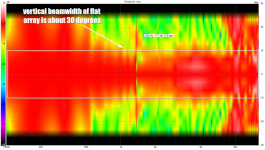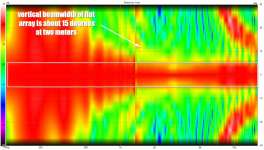The three polar sims in post 199 are:
1) Horizontal, to the right
2) Horizontal, to the left
3) vertical
The Bessel array is five tweeters and it's oriented horizontally.
1) Horizontal, to the right
2) Horizontal, to the left
3) vertical
The Bessel array is five tweeters and it's oriented horizontally.
FYI
For a line array, the polar response is simply the FFT of the driver signals. This means that one can actually work backwards from a wanted polar to what the drivers have to do to get there.
If it's a rectangular array then its a 2D FFT, and if it's round then it is a Bessel transform, just like in lense theory.
For a line array, the polar response is simply the FFT of the driver signals. This means that one can actually work backwards from a wanted polar to what the drivers have to do to get there.
If it's a rectangular array then its a 2D FFT, and if it's round then it is a Bessel transform, just like in lense theory.
I ran some sims on a fifteen element array of 2.5" drivers (Dayton ND64-16) and found that the performance is strongly impacted by how far you are from the array.
I imagine that's part of the reason that shading is so useful; when you have an array that's a meter in height, the closer you are to the array, the worse the pathlengths are.
IE -
If you're half a meter away, the pathlengths will be a mess, and the elements at the top and the bottom of the array will be significantly out-of-phase. This screws up the vertical polar response and widens the beamwidth but only at close range.
As you move further and further from the array, the performance improves. Taken to the extreme, if you were a hundred meters away from an array that's flat, the pathlengths would be virtually identical.
The conculusion is obvious: if you're going to be listening close to the array, you need to come up with a solution.
There are three obvious solutions:
1) Make the array concave so the sound is focused at a specific distance. Basically equalize the pathlengths
2) Shade the array so that the elements at the top and the bottom are contributing less
3) Use a low pass on the elements at the edge of the array. Basically a variation on option 2, except you're "shading" the array at high frequencies only
I imagine that's part of the reason that shading is so useful; when you have an array that's a meter in height, the closer you are to the array, the worse the pathlengths are.
IE -
If you're half a meter away, the pathlengths will be a mess, and the elements at the top and the bottom of the array will be significantly out-of-phase. This screws up the vertical polar response and widens the beamwidth but only at close range.
As you move further and further from the array, the performance improves. Taken to the extreme, if you were a hundred meters away from an array that's flat, the pathlengths would be virtually identical.
The conculusion is obvious: if you're going to be listening close to the array, you need to come up with a solution.
There are three obvious solutions:
1) Make the array concave so the sound is focused at a specific distance. Basically equalize the pathlengths
2) Shade the array so that the elements at the top and the bottom are contributing less
3) Use a low pass on the elements at the edge of the array. Basically a variation on option 2, except you're "shading" the array at high frequencies only
Attachments
Yep; I assume Jim Griffin's White Paper discusses this. 😉 My experimentation was so long ago that I just chose concave without even considering any alternatives and it was fine except for the relatively extreme 'head in vice' experience.
In post 204 I left out the most important part: one sim was done at two meters, and one at four meters.
So moving further from the array improves the overall frequency response and narrows the vertical beamwidth
So moving further from the array improves the overall frequency response and narrows the vertical beamwidth
@DaveFred:

This will get you an 8 ohm load, and if you wire two sets of these in parallel, you will have eight drivers and a 4 ohm load.
I have 8 small 4 ohm tweeters I would like to try this with, wire four in series and then in parallel with the other four for 8 ohms?
- Home
- Loudspeakers
- Multi-Way
- An Improved Array

